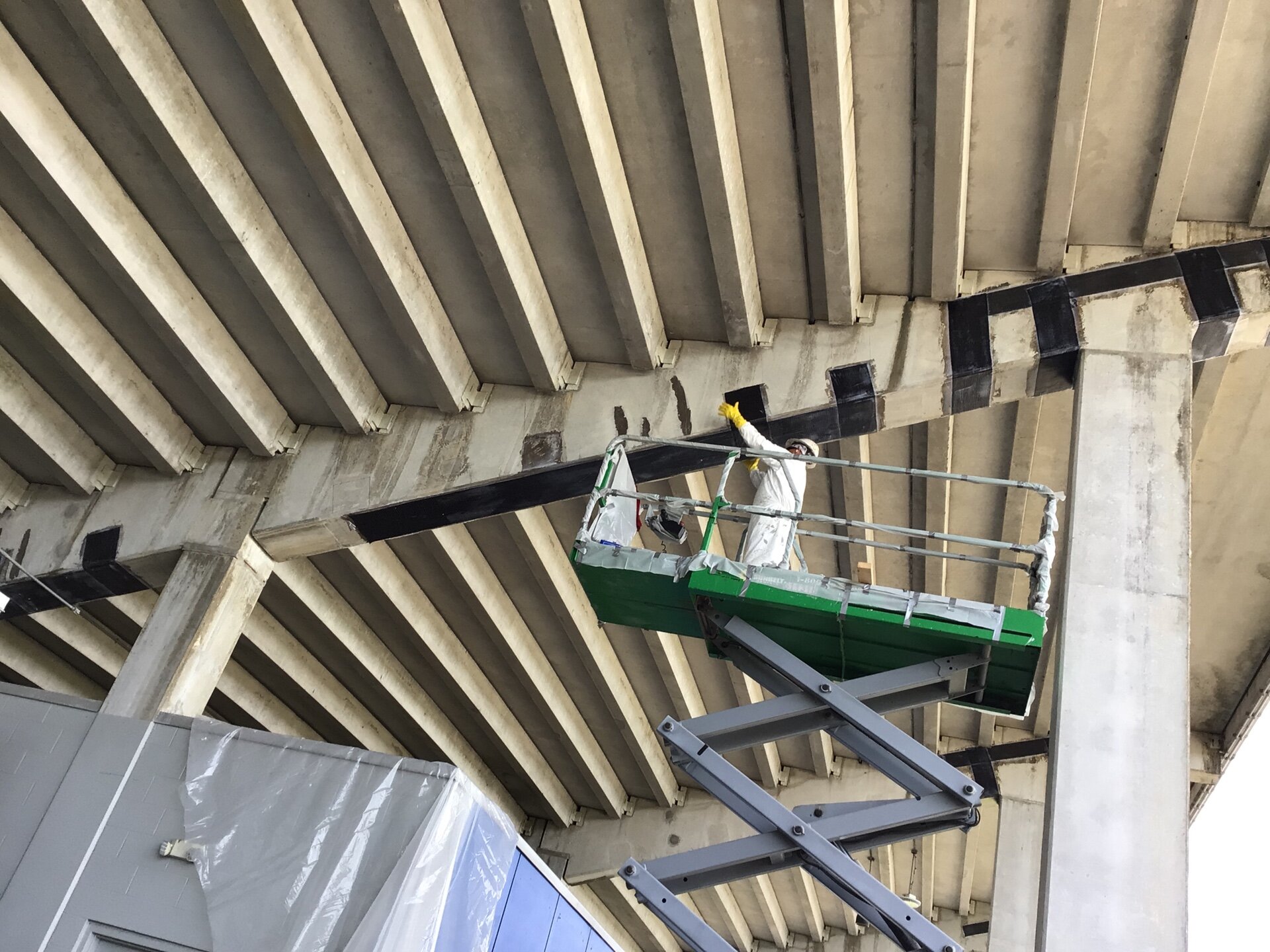Home > Our Services > FRP Reinforcing
FRP REINFORCING
FRP installation (3 sided “U” wrap) on bridge
FRP composite materials are comprised of high strength continuous fibers, such as glass, carbon, or steel wires, embedded in a polymer matrix. The fibers provide the main reinforcing elements while the polymer matrix (epoxy resins) acts as a binder, protects the fibers, and transfers loads to and between the fibers. FRP composites can be manufactured on site using the wet lay-up process in which a dry fabric, made of carbon or glass, is impregnated with epoxy and bonded to prepared concrete substrate. Once cured, the FRP becomes an integral part of the structural element, acting as an externally bonded reinforcing system. FRP composites can also be prefabricated in a manufacturing facility in which the material is pultruded to create different shapes that can be used for strengthening applications, such as rods, bars and plates.
Frequently Asked Questions About FRP Coatings
What does FRP stand for? The FRP that we use stands for Fiber-Reinforced Polymer. FRP can also stand for fiber reinforced plastics.
What is FRP wrapping? Fiber Reinforced Polymer can be made of different materials such as glass, carbon, or steel, all embedded in the polymer matrix. The fibers are the main reinforcing element but are bonded together by a polymer, such as an epoxy resin. This polymer protects the fibers and equally distributes the load between each fiber of material.
How does FRP wrapping work? FRP wraps work by reinforcing the substrate using the strength provided by the fibers. To achieve this, the correct fiber material must be chosen. The most popular fiber is carbon fiber, which is favored for it’s stiffness, durability, and high tensile strength when compared to glass fiber based wraps. Once the proper fiber is picked the structure can be wrapped in the material. One way to apply the fabric to the structure is through the wet lay up process, which involves placing the fabric on the structure and then bonding it to the structure using epoxy. This casts the FRP system to the structure, making it into a new, integral part of the structure. FRP systems can also come prefabricated to match intricate designs of existing structure’s details.
What can FRP wraps be used on? FRP wrap systems can be used on a variety of structures and in a variety of situations. FRP can be used on beams, joists, columns, decks, tunnels, tanks, pipes, silos, and much more.
Why use FRP? There are many reasons why people opt to use FRP systems in place of traditional reinforcement systems. FRP systems can be offer reduced labor costs, less downtime during installation, and an overall more cost effective option than traditional methods.
LEARN THE DIFFERENCE BETWEEN THE DIFFERENT TYPES OF FRP MATERIALS:
THE CSC DIFFERENCE:
At CSC, we stabilize your substrate before FRP application. What this means for our clients is that the substrate is not only stronger upon application, but the entire application will last much longer.

See how we do FRP Reinforcing…
CASE STUDY: OLIN LIBRARY
FRP reinforcement was needed to strengthen areas identified by Streeter Associates. FRP was identified as the best solution for this reinforcement, for it's minimal footprint on the jobsite and for the strength that it provides, without additional beams or structural solutions being added to the existing structure.
CASE STUDY: BUCKS COUNTY PARKING GARAGE
The existing structure has fallen into disrepair and requires numerous concrete repairs, joint sealant replacement, composite strengthening and numerous other miscellaneous repair items. Coordinated Systems Consulting outlined FRP composite strengthening for the pre-cast tees in flexure as well as shear reinforcing as noted on the plans.



